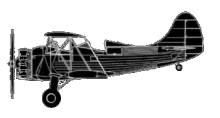
ASN Wikibase Occurrence # 188494
This information is added by users of ASN. Neither ASN nor the Flight Safety Foundation are responsible for the completeness or correctness of this information.
If you feel this information is incomplete or incorrect, you can submit corrected information.
| Date: | Saturday 2 July 2016 |
| Time: | 16:00 |
| Type: |  Waco YMF-F5C |
| Owner/operator: | Private |
| Registration: | N30AB |
| MSN: | F5C-8-129 |
| Year of manufacture: | 1998 |
| Total airframe hrs: | 411 hours |
| Engine model: | Jacobs R55A2M |
| Fatalities: | Fatalities: 0 / Occupants: 3 |
| Aircraft damage: | Substantial |
| Category: | Accident |
| Location: | Windy Point, Lake Travis, NW Austin, TX -
 United States of America United States of America
|
| Phase: | En route |
| Nature: | Survey |
| Departure airport: | Austin, TX (AUS) |
| Austin, TX (AUS) | |
| Investigating agency: | NTSB |
| Confidence Rating: |
The airline transport pilot departed on an aerial observation tour flight with two passengers. About 25 minutes into the flight, the engine experienced a total loss of power while overflying a lake. One of the passengers stated that it sounded like the pilot was trying to get the engine “going” multiple times and that the engine sounded like a motorcycle or lawnmower when it was running out of fuel. The pilot ditched the airplane about 100 yards from the shore, and the airplane nosed over during the ditching. All occupants egressed and were assisted by boaters in the area.
The airplane's total usable fuel quantity was 72 gallons, with 24 gallons usable in each of the two main wing fuel tanks, and 12 gallons usable in each of the two auxiliary fuel tanks. The left fuel selector handle controlled the fuel flow from the left tanks, and the right fuel selector controlled the flow from the right tanks. Postaccident observations of the wreckage revealed the right fuel selector handle was in the OFF position, and the left fuel selector was in the ON position; thus, the engine was running on fuel being fed from the left tanks only.
The airplane was last fueled five days before the accident, at which time all of the tanks were "topped off." Subsequent flight and ground operations on the days before the accident flight burned about 32.5 gallons of fuel. Given the airplane’s fuel burn was about 15 gallons per hour, the airplane would have consumed about 6 gallons during the accident flight before the loss of engine power. It is likely that the airplane had been flown only on the left tanks on the days before and the day of the accident flight, burning all of the usable fuel in the left tanks, despite available fuel in the right tanks.
The pilot reported that he used the airplane’s electronic engine monitor and visual sight gauges to determine the fuel on board during the accident preflight inspection. Although the airplane had sufficient fuel onboard to complete the flight, the pilot likely did not verify the position of the fuel selectors and the fuel gauge readings, which resulted in fuel starvation when the left wing fuel supply was exhausted and the right wing fuel selector remained in the off position.
Probable Cause: The pilot's fuel mismanagement, which resulted in a total loss of engine power due to fuel starvation.
Accident investigation:
 |
|
Sources:
NTSB
Location
Revision history:
| Date/time | Contributor | Updates |
|---|---|---|
| 02-Jul-2016 22:55 | Geno | Added |
| 02-Jul-2016 23:07 | Geno | Updated [Source, Narrative] |
| 02-Jul-2016 23:16 | Geno | Updated [Phase, Nature, Departure airport, Destination airport, Source, Damage, Narrative] |
| 03-Jul-2016 04:38 | Geno | Updated [Aircraft type, Registration, Cn, Operator, Source] |
| 03-Jul-2016 16:40 | harro | Updated [Aircraft type] |
| 19-Aug-2017 07:37 | ASN Update Bot | Updated [Time, Operator, Other fatalities, Nature, Departure airport, Destination airport, Source, Narrative] |
| 19-Aug-2017 07:43 | ASN Update Bot | Updated [Narrative] |
Corrections or additions? ... Edit this accident description
The Aviation Safety Network is an exclusive service provided by:


 ©2024 Flight Safety Foundation
©2024 Flight Safety Foundation